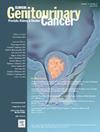The Clinical Trajectory of Prostate Cancer Patients Harboring Rare Histological Subtypes—A Retrospective Cohort Trial
IF 2.7
3区 医学
Q3 ONCOLOGY
引用次数: 0
Abstract
Background
Acinar adenocarcinoma is the most common histological subtype of prostate cancer (PCa). However, 5% of cases present with unconventional histological subtypes (UHs), which have inconsistent clinical characteristics.
Patients and Methods
600 patients underwent a radical prostatectomy (RP) at our institution between 2003 and 2023. 50% had UHs, while other 50% age-matched patients (median age 63 years), with pure acinar adenocarcinoma served as comparison group. Collected parameters included age at diagnosis, PSA levels, imaging results, ISUP (International Society of Urological Pathology) Grade Group at biopsy and RP, TNM-stage and biochemical recurrence rates (BCR). Statistical analysis was conducted using SPSS and Excel, applying Mann-Whitney-U, Chi-Square tests, and Cox proportional hazards models to assess associations with recurrence-free survival.
Results
All patients with UHs presented mixed histological forms (P < .001). Importantly, UHs were previously identified only in 9% of biopsy specimens (P < .001). Patients with UHs had more aggressive disease reflected by higher ISUP Grade Group (P < .001), higher prevalence of ≥pT3a tumors as well as higher rates of positive resection margins (P < .001) although fewer nerve-sparing procedures were performed (P < .001). Patients with UH had a higher risk of PSA persistence after RP (P = .04) and higher BCR rates (P < .001) after a median follow-up of 54.8 months. Notably, multivariate Cox regression analysis indicated that the presence of UHs is the most significant risk factor for BCR (HR 1.972, 95% CI 1.210-3.312).
Conclusion
Patients with UH exhibit more aggressive disease and have an increased risk of disease relapse following curative therapy.
具有罕见组织学亚型的前列腺癌患者的临床轨迹——一项回顾性队列试验
背景腺泡腺癌是前列腺癌(PCa)最常见的组织学亚型。然而,5%的病例表现为非常规组织学亚型(UHs),其临床特征不一致。患者和方法2003年至2023年间,我院有600例患者接受了根治性前列腺切除术(RP)。50%的患者患有UHs,另外50%的患者年龄匹配(中位年龄63岁),纯腺泡腺癌作为对照组。收集的参数包括诊断时年龄、PSA水平、影像学结果、ISUP(国际泌尿病理学会)活检和RP分级组、tnm分期和生化复发率(BCR)。采用SPSS和Excel进行统计分析,采用Mann-Whitney-U检验、卡方检验和Cox比例风险模型评估与无复发生存期的相关性。结果所有UHs患者均呈现混合型组织学形态(P <;措施)。重要的是,以前仅在9%的活检标本中发现了UHs (P <;措施)。UHs患者疾病侵袭性更强,ISUP分级高组(P <;.001),≥pT3a肿瘤的患病率较高,切缘阳性发生率较高(P <;.001),但较少进行神经保留手术(P <;措施)。UH患者RP后PSA持续存在的风险更高(P = 0.04), BCR率更高(P <;.001),中位随访54.8个月。值得注意的是,多因素Cox回归分析显示,UHs的存在是BCR最显著的危险因素(HR 1.972, 95% CI 1.210 ~ 3.312)。结论UH患者在根治性治疗后表现出更强的侵袭性,疾病复发的风险增加。
本文章由计算机程序翻译,如有差异,请以英文原文为准。
求助全文
约1分钟内获得全文
求助全文
来源期刊

Clinical genitourinary cancer
医学-泌尿学与肾脏学
CiteScore
5.20
自引率
6.20%
发文量
201
审稿时长
54 days
期刊介绍:
Clinical Genitourinary Cancer is a peer-reviewed journal that publishes original articles describing various aspects of clinical and translational research in genitourinary cancers. Clinical Genitourinary Cancer is devoted to articles on detection, diagnosis, prevention, and treatment of genitourinary cancers. The main emphasis is on recent scientific developments in all areas related to genitourinary malignancies. Specific areas of interest include clinical research and mechanistic approaches; drug sensitivity and resistance; gene and antisense therapy; pathology, markers, and prognostic indicators; chemoprevention strategies; multimodality therapy; and integration of various approaches.
 求助内容:
求助内容: 应助结果提醒方式:
应助结果提醒方式:


